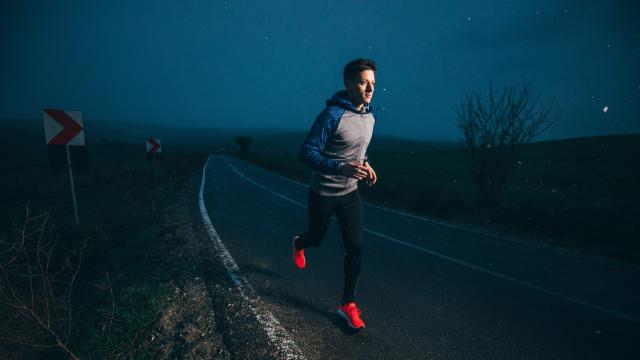Exercising outdoors in the winter often means exercising in the dark, whether you’re getting up before dawn or lacing up after work as the sun is going down. That’s no problem, as long as you know how to stay safe.
It will be cold
Nights are colder than days, so don’t expect your pre-dawn runs to be as warm as your midday ones. Check the hourly weather forecast with an app like DarkSky (make sure to look at the “feels like” temperature, too). Then take our advice on dressing to stay warm while you run.
If you’re cycling, you have to deal with the wind as well. Glasses or goggles can keep wind out of your eyes, and don’t forget to layer up on gloves, too. Consider glove liners or windproof gloves.
Bring a flashlight, even if you aren’t sure you’ll need it
I learned this one the hard way when I was into trail running. If the sun was due to set at 6 p.m., I would make sure to have a flashlight in my pocket if I’d be in the woods anytime after five. Light would start fading well in advance of the official sunlight time, thanks to all those hills and trees, or sometimes I’d be out longer than I expected. And when I lost even a little bit of light, it was suddenly a lot easier to stub my toe on roots and rocks in the path. Now I always carry a pocket-sized flashlight, even if I don’t think I’m going to need it.
Even if you’re just walking in your neighbourhood, it’s good to be seen. I’ve been in pitch-dark parks where I didn’t realise another jogger was there until they were right in front of me. Carrying some kind of light can help you see people, but it can also help you avoid terrifying everyone else.
Light is also important if you’re cycling. You especially want to make sure cars can see you, so put on your front and back lights even if it’s not fully dark yet. The convention (which is also the legal requirement in many areas) is to put a bright white light at the front of your bike, and a red light for visibility at the back. That back light could be mounted to your bike or to another convenient spot, like clipped onto your jacket or helmet.
If you’re a runner, a hand-held flashlight is great, but a headlamp is often more useful. Whatever you use, know the battery life and make sure your light is fully charged before you go.
Wear reflective clothing
Light colours are more visible than dark ones, and neon-coloured high-visibility fabrics can help you appear brighter as the sun is going down. But neither one is a replacement for reflective gear, which shines straight back at a light source like the headlights of a car.
If you’re cycling, your wheels and pedals may already have reflectors on them; if not, you can buy some at a bike store.
Running shoes and jackets often have reflective accents on them, but they’re often small. Use a flashlight to find out just how reflective your gear is.
You don’t have to buy a fully reflective jacket or pants, although that’s a good option. Reflective spots on your head, body, and feet can help drivers recognise that you’re a person-shaped object they shouldn’t hit. You can buy reflective tape to add to what you already own, or buy accessories like a reflective hat and reflective ankle bands or wrist bands. You can also strap on a reflective, high-visibility vest over whatever you’re wearing.
Stay safe
When you head out, pay extra attention to your surroundings. That flashlight will help, and it’s best to run without headphones, or to keep the volume very low.
Bring a buddy if you can. It’s probably best to stick with buddies in your household. If you have a dog, you can probably train them to run with you, but remember that they may need to improve their fitness over time to keep up.
Run on the correct side of the road (the left, facing traffic) and stay alert to your surroundings. Plan out your route before you leave to make sure you’re not going anywhere you’re not comfortable with. A nighttime run is not the best time to find yourself lost in an unfamiliar neighbourhood or unsure of whether there’s a safe crossing over a busy road.
For extra reassurance, make sure somebody knows where you are. Any time I run in a new place or on a trail, I use the location sharing on Google Maps so my husband can find me in case of an emergency. (Call me a worrier, but I have visions of falling down a hill and breaking a leg. It’s never happened, of course.) You can set up the equivalent feature on an iPhone with Find My Friends.

Leave a Reply
You must be logged in to post a comment.